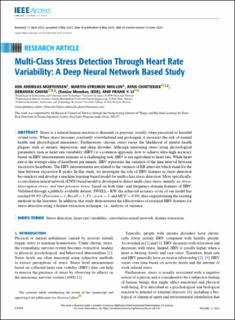| dc.contributor.author | Mortensen, Jon Andreas | |
| dc.contributor.author | Mollov, Martin Efremov | |
| dc.contributor.author | Chatterjee, Ayan | |
| dc.contributor.author | Ghose, Debasish | |
| dc.contributor.author | Li, Frank Yong | |
| dc.date.accessioned | 2024-04-12T06:21:44Z | |
| dc.date.available | 2024-04-12T06:21:44Z | |
| dc.date.created | 2023-07-12T12:39:26Z | |
| dc.date.issued | 2023 | |
| dc.identifier.citation | Mortensen, J. A., Mollov, M. E., Chatterjee, A., Ghose, D., Li, F. Y. (2023). Multi-Class Stress Detection Through Heart Rate Variability: A Deep Neural Network Based Study. IEEE Access, 11, 57470-57480. | en_US |
| dc.identifier.issn | 2169-3536 | |
| dc.identifier.uri | https://hdl.handle.net/11250/3126186 | |
| dc.description.abstract | Stress is a natural human reaction to demands or pressure, usually when perceived as harmful or/and toxic. When stress becomes constantly overwhelmed and prolonged, it increases the risk of mental health and physiological uneasiness. Furthermore, chronic stress raises the likelihood of mental health plagues such as anxiety, depression, and sleep disorder. Although measuring stress using physiological parameters such as heart rate variability (HRV) is a common approach, how to achieve ultra-high accuracy based on HRV measurements remains as a challenging task. HRV is not equivalent to heart rate. While heart rate is the average value of heartbeats per minute, HRV represents the variation of the time interval between successive heartbeats. The HRV measurements are related to the variance of RR intervals which stand for the time between successive R peaks. In this study, we investigate the role of HRV features as stress detection bio-markers and develop a machine learning-based model for multi-class stress detection. More specifically, a convolution neural network (CNN) based model is developed to detect multi-class stress, namely, no stress, interruption stress, and time pressure stress, based on both time- and frequency-domain features of HRV. Validated through a publicly available dataset, SWELL−KW, the achieved accuracy score of our model has reached 99.9% (Precision = 1, Recall = 1, F1−score = 1, and MCC = 0.99), thus outperforming the existing methods in the literature. In addition, this study demonstrates the effectiveness of essential HRV features for stress detection using a feature extraction technique, i.e., analysis of variance. | en_US |
| dc.language.iso | eng | en_US |
| dc.publisher | IEEE | en_US |
| dc.rights | Attribution-NonCommercial-NoDerivatives 4.0 Internasjonal | |
| dc.rights.uri | http://creativecommons.org/licenses/by-nc-nd/4.0/deed.no | |
| dc.title | Multi-Class Stress Detection Through Heart Rate Variability: A Deep Neural Network Based Study | en_US |
| dc.title.alternative | Multi-Class Stress Detection Through Heart Rate Variability: A Deep Neural Network Based Study | en_US |
| dc.type | Peer reviewed | en_US |
| dc.type | Journal article | en_US |
| dc.description.version | publishedVersion | en_US |
| dc.rights.holder | © 2023 The Author(s) | en_US |
| dc.subject.nsi | VDP::Teknologi: 500::Informasjons- og kommunikasjonsteknologi: 550 | en_US |
| dc.source.pagenumber | 57470-57480 | en_US |
| dc.source.volume | 11 | en_US |
| dc.source.journal | IEEE Access | en_US |
| dc.identifier.doi | 10.1109/ACCESS.2023.3274478 | |
| dc.identifier.cristin | 2162118 | |
| cristin.qualitycode | 1 | |

